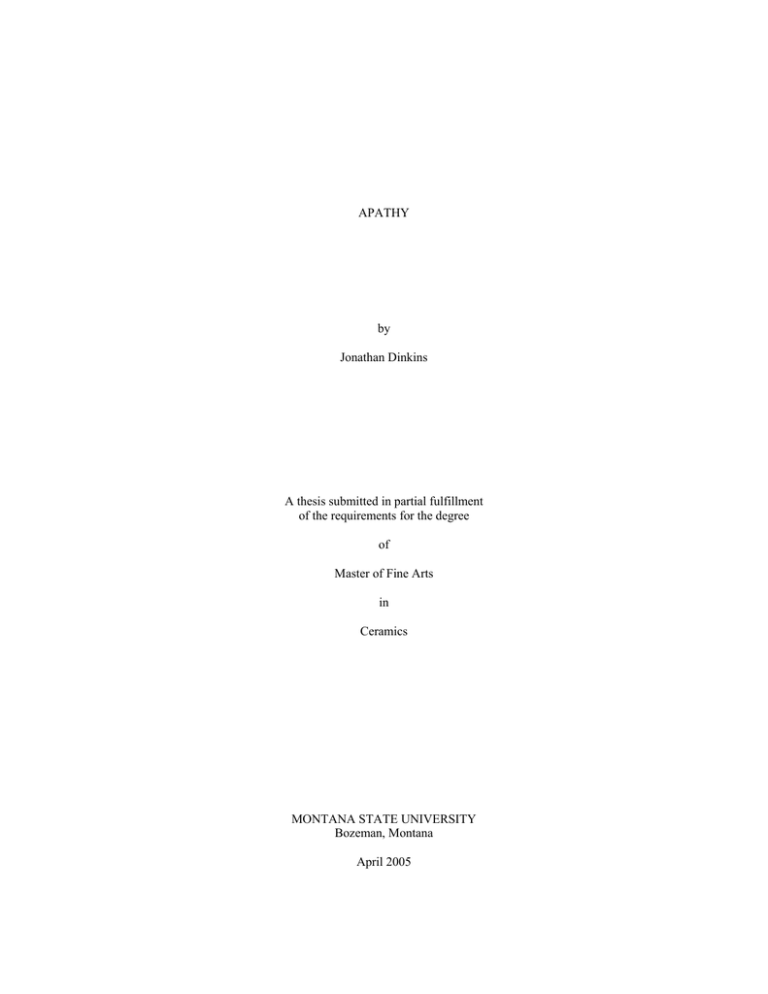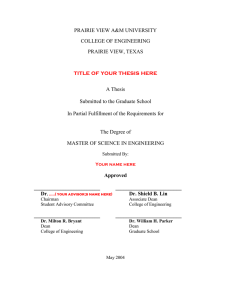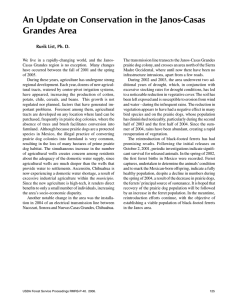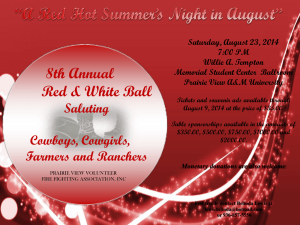
APATHY
by
Jonathan Dinkins
A thesis submitted in partial fulfillment
of the requirements for the degree
of
Master of Fine Arts
in
Ceramics
MONTANA STATE UNIVERSITY
Bozeman, Montana
April 2005
©COPYRIGHT
by
Jonathan Dinkins
2005
All Rights Reserved
ii
APPROVAL
of a thesis submitted by
Jonathan Dinkins
This thesis has been read by each member of the thesis committee and has been found to be satisfactory regarding
content, English usage, format, citations, bibliographic style, and consistency, and is ready for submission to the
College of Graduate Studies.
Chairperson, Graduate Committee
Michael Peed
April 18, 2005
Approved for the School of Art
Head, Major Department
Richard Helzer
April 18, 2005
Approved for the College of Graduate Studies
Graduate Dean
Dr. Bruce McLeod
April 18, 2005
iii
STATEMENT OF PERMISSION TO USE
In presenting this thesis in partial fulfillment of the requirements for a master's degree at Montana
State University, I agree that the Library shall make it available to borrowers under rules of the Library.
If I have indicated my intention to copyright this thesis by including a copyright notice page,
copying is allowable only for scholarly purposes, consistent with "fair use" as prescribed in the U.S.
Copyright Law. Requests for permission for extended quotation from or reproduction of this thesis in
whole or in parts may be granted only by the copyright holder.
Johnathan Dinkins
April 18, 2005
iv
LIST OF IMAGES
Images
Page
1. Paper Bag, 4’ x 2' x 5’, clay…....……..………..........................................................4
2. Paper Bag, side view...................................................................................................5
3. Paper Bag, detail........................…………………….….....………………………...6
4. Big Fish, 11’ x 5’ x 2’6”, clay.....................................................................................7
5. Big Fish, side view.........................…………..……...................................................8
6. Big Fish, detail.....................................................………………………...................9
7. Plastic, 4’6” x 3’ x 3’6”, clay .......…….……………………………………............10
8. Plastic, side view……………………........................................................................11
9. Plastic, detail.............………………………….………………………....................12
10. Reintroduction, 5’6” x 3’ x 5’6”, clay .……………..................................................13
11. Reintroduction, back view....……………………………………….........................14
12. Reintroduction, detail……………………………………………….........................15
13. Reintroduction, detail.............…………………………………………....................16
14. Pesticide, 4’6” x 6’ x 4’2”, clay.……………………………………........................17
15. Pesticide, side view....................................................................................................18
16. Pesticide, detail...........................................................................................................19
17. Oily Bird, 3’ x 2’ x 2’3”, clay....................................................................................20
18. Oily Bird, side view....................................................................................................21
19. Prairie Dog Hunt, 8’ x 5’ x 3’, clay............................................................................22
20. Prairie Dog Hunt, detail..............................................................................................23
v
LIST OF IMAGES CONTINUED
Images
Page
21. Prairie Dog Hunt, side view………............................................................................24
22. Prairie Dog Hunt, detail……………………………………………..........................25
23. Poacher, 1’9” x 1’6” x 2’3”, clay................................................................................26
24. Poacher, side view.......................................................................................................27
25. Gallery View #1…………………………………………………………...................28
26. Gallery View #2…………………………………………….......................................29
27. Gallery View #3………………………………….......................................................30
1
In this show, I’m commenting on the apathetic attitudes of our society that I find
appalling. Our culture has become a thoughtless throw-away society with an unhealthy
consumer drive. We are fixated on fast-everything along with its ‘disposable’ packaging. The
willing and un-willing deterioration of the environment; seen through thoughtless (inhumane)
killing for pleasure, unmanaged pest-control, littering, oil spills, and the desire to drill in refuge
areas (ANWAR and East Front Glacier National Park); has created a consumer culture that relies
on ignorance to excuse itself from environmental degradation. I believe abuses of the
environment are indicators of our society’s more wide spread apathetic attitudes. The
environment can also be thought of as a metaphor, the destruction of ecosystems on the premise
of development and modernization will bring about the destruction of our species, because we
are dependent on the environment for our existence. We are just as dependent on each other for
the survival of our species; yet, our consumer culture and lack of understanding and tolerance
have provided avenues for the proliferation of destructive behaviors against each other for
monetary ends (war, Enron scandal, prejudice, etc.). The big business driven, oil industry and
material consumption seem to control our country’s social and political systems, which not only
destroy the environment but our social relationships with other citizens of this planet.
As a sculptor, figurative objects are my means of exploring and communicating ideas that
represent my reaction and digestion of social behaviors. Apathy toward the environment and the
world in general is found all around us in political, social, and cultural contexts. My comments
are based on my education, observation, and perception of the attitudes of a large portion of
individuals within our society. The environmental theme acts as metaphor and indicator of the ill
effects of the consumer culture that we are surrounded by. Deeper meaning can be searched out
2
and interpreted in these monumental sculptural forms presented as large scale human and animal
figures. Monumental size places significance on the issues presented by each piece, while the
intriguing forms emphasized by flowing monochromatic color persuade viewer into looking at
them. I purposefully give no solutions to the direct or indirect issues presented within these
sculptures, because I feel there may not be a black or white solution. I only give illusions to my
opinions through my translation of environmental problems into contemptuous, cynical, or
sarcastic monuments to highlight the apparent absurdity of society’s treatment of the problems
around us.
Of my many influences Robert Arneson, Charles Ray, and Juan Munõz are three artists
that I’ve been gravitating toward for the past couple of years. These influences and my work are
a completion of ideas from various social situations. I strongly relate to Robert Arneson’s
sarcastic response to the political world and how the finished look of his ceramic sculptures
seems to reinforce his message. Charles Ray and Juan Munõz have been influences with their
mundane sculptures of people or ideas that make viewers try to comprehend their meaning.
These artists have produced figurative sculptures that force an audience to wonder about the
intentions behind the artwork.
My contemptuous manner of presentation intends to show viewers how easily we
disregard and overlook serious social issues, because these issues do not seem to directly affect
them. Hopefully, these monuments to our apathy force viewers to realize how important
seemingly small and distant environmental and social problems can affect them. Sarcasm
simplifies an issue by focusing on the main points or take-home message of a topic; it is also
dependent on the emotions or feelings behind a social issue, which encourages viewers to go
3
away contemplating social problems. Emphasizing emotional reactions to the main points and
forgetting the details of an issue, forces viewers to assign judgment to an issue without thinking
of the repercussions of the details. My objects are intended to give a slight uneasiness or a false
feeling of security, because the figures are sculpted in a mostly innocent looking style. My way
of communicating my views on social issues consists of putting a sarcastic twist on issues to
provoke emotions. So look at these cynical monuments to our consumption of the environment
and formulate your own opinion about what the consumer culture means to you.
4
Image 1 – Paper Bag
5
Image 2 – Paper Bag, side view
6
Image 3 – Paper Bag, detail
7
Image 4 – Big Fish
8
Image 5 – Big Fish, side view
9
Image 6 – Big Fish, detail
10
Image 7 – Plastic
11
Image 8 – Plastic, side view
12
Image 9 – Plastic, back view
13
Image 10 – Reintroduction
14
Image 11 – Reintroduction, back view
15
Image 12 – Reintroduction, detail
16
Image 13 – Reintroduction, detail
17
Image 14 – Pesticide
18
Image 15 – Pesticide, side view
19
Image 16 – Pesticide, detail
20
Image 17 – Oily Bird
21
Image 18 – Oil Bird, side view
22
Image 19 – Prairie Dog Hunt
23
Image 20 – Prairie Dog Hunt, detail
24
Image 21 – Prairie Dog Hunt, side view
25
Image 22 – Prairie Dog Hunt, detail
26
Image 23 – Poacher
27
Image 24 – Poacher, side view
28
Image 25 – Gallery View #1
29
Image 26 – Gallery View #2
30
Image 27 – Gallery View #3






